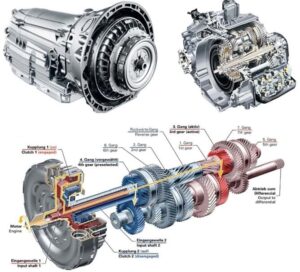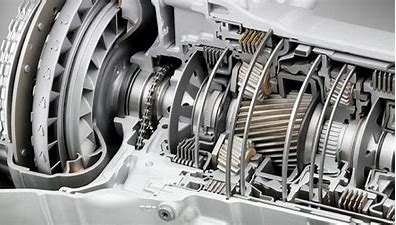Have trouble changing the gears? Does your transmission refuse to go into gear? Or does it get stuck at the first gear (or drive)? Then obviously, there is a problem with the transmission system of your car and you should fix it as soon as possible. So, let us discuss your problem of transmission not shifting out of first gear and look for the solutions.
Table of Contents
Why Do We Need The Transmission System?
Before discussing your problem of automatic transmission not shifting into gear, I think you should know some basics of the transmission system. Don’t worry, I am not going to start a mechanics lecture here, but tell you why you need the transmission system in your car. You must know that the engine is where the power is produced by the fuel, right.

But this power needs to be delivered to the wheels to move your car. Well, the transmission system is the one that does this work and keeps your wheels spinning, and helps your engine to remain at a fixed rpm.
How To Fix Transmission Not Shifting Out Of First Gear?
Now, let us discuss all the causes that could cause your manual transmission not to shift out of first gear and look for the solutions. We have also provided video links to every problem to help you understand it better.
1. Check The Clutch
If you find that the clutch pedal has become hard and needs a lot of pressure to be pressed down, this would not allow you to shift the gears smoothly. Or, if you find that your engine is revving while changing the gears, the clutch is the one that’s causing the problem. Not pressing the clutch completely could cause damage to the transmission system of your car, therefore, you should fix it immediately.
How To Fix It?
If the clutch pedal has become hard, you just need to service the clutch so that you don’t need to apply a lot of pressure on the clutch to change the gears. But, if engine revving is the problem, you need to repair or mostly replace the clutch. Check out the video link below. It has some good information about the clutch of your car and knows if you need to replace it.
2. Check The Transmission Fluid
The transmission fluid is a very essential component of your car’s transmission system and acts as a lubricant for all the moving parts in the transmission system. As you know, the transmission system is the one that spins the wheels with the help of various components and there is a lot of friction between these components. So, the transmission fluid is very essential to make the friction as low as possible to make your car work smoothly and efficiently.
How To Fix It?
Hard shifts between gears, delay in acceleration, or hearing grinding noises while changing gears are signs of low transmission fluid. If you refilled the transmission fluid recently, then there could be a leakage in it. Get this problem fixed and you are good to go. You can refer to the video link below to diagnose transmission fluid leakage.
3. Check The Engine Control Unit (ECU)
In automatic transmission vehicles, the ECU provided the data to the system about when to change the gears for optimum efficiency and performance. Any problem in the ECU or an outdated ECU could lead to the manual transmission not shifting out of first gear.
How To Fix It?
Fixing a car ECU is a difficult task for you to do. It consists of various complicated circuits and installed programs that should be handled by a professional only. Also, you should avoid driving your car if you think that the ECU is damaged and call up your mechanic to check it out. Check out the video link provided below for some information on the ECU.
4. Check The Gear Synchronizers
The purpose of gear synchronizers is to make your transitions quick and smooth. If there is any problem in the synchronizers or if the gears aren’t synchronized properly, the gears will not shift smoothly and you could experience manual transmission not shifting out of first gear.
How To Fix It?
Gear Synchronizers are located inside the transmission system and are very sensitive components. They should be handled and fixed by a professional only. Also, a damaged synchronizer could be identified by a professional only. We have provided a video link below that could help you grab some information on the working of the gear synchronizer.
5. Check The Torque Converter
In automatic transmission systems, the torque converter pressurizes the transmission fluid to provide the necessary force for shifting gears. If there is any problem with the pump, stator, or the turbine in the converter, the transmission of gears would be difficult. The transmission may even slip in and out of gear. So, you need to fix it immediately.
How To Fix It?
Fixing the damaged torque converter would solve the problem. This problem too should be handled by a professional only. Check out the video link below. It has some great information on the working of a torque converter.
6. Check Human Error
Sometimes, we might overthink and overlook simple solutions to a problem. It could happen that you might not be pressing the clutch down which is essential for the proper shifting of gears. If your car has an automatic transmission, make sure you are pressing the brake when you are shifting to “park”. Not pressing the clutch properly could also cause damage to your car. Check out the video link below.
Frequently Asked Question-related to Transmission Systems:
So,here are some frequently asked questions about why the cars having transmission, how the connection incurred ,to know how the transmission got bad-
Why Do Cars Have Transmissions?
The useable/maximum torque output of the internal combustion engine is fairly limited to a small range of engine speed, so gears are needed to keep the engine in the required RPM range at varying road speeds without stalling the engine or overspeeding it.
How Is the Engine Connected to the Transmission System?
The transmission generally is connected to the engine crankshaft via a flywheel or clutch or fluid coupling, partly because internal combustion engines cannot run below a particular speed. The output of the transmission is transmitted via the driveshaft to one or more differentials, which drive the wheels.
Why Won’t My Transmission Shift into Gear?
Usually, one of the main causes which the automatic transmission does not shift into high gears or won’t change gears at all is often a lack of fluid in the system
How Do You Know If Your Car Transmission Is Bad?
There can be several reasons The transmission won’t shift and the car makes a grinding sound when the engine is running. Besides, pulling out of first gear will feel harder than normal. The transmission will shift in and out of gear without any issue when the car is not running. It won’t come out of the reverse gear when the car is running.
Is There a Gear Shift in an Automatic Transmission Car?
There is no gear shift in an automatic transmission car, so once you put the transmission into drive, everything else is automatic
Final Words
We have discussed all the causes that could cause the problem of transmission won’t shift when accelerating and have looked for its solutions. The transmission system is one of the most essential components of your car. Any problem related to it should be taken care of immediately to avoid further complications and unnecessary waste of money and time.
If you like this article and have any queries, let us know in the comment section below.
Cheers!



